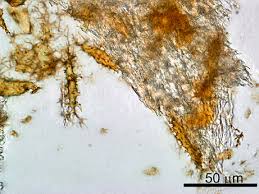By Brad Harrub, Ph.D.
It was one hundred years ago this year that Henry Fairfield Osborn described and named Tyrannosaurus Rex —meaning “tyrant lizard.” Three years later in 1908, Osburn would begin serving a twenty-seven year term as president of the American Museum of Natural History in New York. It was Osburn who made this creature a household name by giving it the shorthand label that is now commonplace: T. rex. But unbeknownst to him, the creature Osburn identified as T. rex had already been named—almost twelve years earlier. In 1892, world-renowned paleontologist Edward Drinker Cope named the same creature Manospondylus gigas, based on the finding of a single bone. Since Cope’s discovery was named from a sole bone, Osburn had no way of knowing they had both described the same creature. In the one hundred years following Osburn’s description, the T. rex has become the most famous of all dinosaurs. It, along with a host of over 900 other valid genuses of dinosaurs, captivates the hearts and minds of young and old alike.
This evident fascination with dinosaurs may explain why Newsweek has once again featured a cover story on dinosaurs. The June 27, 2005 issue features an artist’s representation of an allegedly feathered dinosaur above the banner: “Rediscovering Dinosaurs—Beyond T. Rex: How They Really Lived.” The evolutionary propaganda begins with the opening sentence of the accompanying article: “Seventy-seven million years ago—nearing the end of the age of dinosaurs, although they still had 12 million years to go—a young duck-billed hadrosaur lay down to die just over the horizon from the vast inland sea that covered much of central North America” (Adler, 2005, 145:45). A beautiful opening sentence that probably took the author a great deal of thought to nail down the finished version for the article. But consider how much of this verbiage is pure speculation and evolutionary hype. Exactly how did author Jerry Adler come to the knowledge that:
• this particular fossil was 77 million years old?
• this alleged incident took place near the end of the age of dinosaurs?
• 12 million years remained in the age of dinosaurs?
• this dinosaur simply laid down to die?
• a “vast inland sea that covered much of central North America” ever existed?
Adler’s closing remarks are hardly any better—giving a whole new meaning to the words “supposition” and “creative license.” He noted:
They lived for millions of years, but they were perilously close to extinction; the climate may have already been changing, for reasons still being debated; the meteorite that would end the Cretaceous Period with a bang was spinning through space on its way toward its fateful impact with Earth. And all were awaiting the evolution of an unimaginable creature that would someday calculate the trajectory of comets, and dig up the long-buried bones to probe their secrets—and marvel at the intricacy and beauty of it all (p. 52).
How does he know:
• these creatures lived for millions of years?
• these creatures were perilously close to extinction?
• the climate may have been changing?
• a meteorite ended the Cretaceous Period?
• that there was even a Cretaceous Period?
• and that unimaginable creatures (humans) evolved?
Adler clearly left the field of science, and walked boldly and unabashedly into the realm of science fiction. And yet, his penmanship appears as a cover story for Newsweek magazine!
Had he stuck to reporting the facts, readers would have experienced an unbiased introduction to a recent discovery made by Nate Murphy. After much spin and hyperbole, Adler finally recorded:
It was on a fossil-hunting trip in the summer of 2000 that one of Murphy’s volunteers spotted a bone poking out of a low west-facing bluff in the remote reaches of a cattle ranch north of Malta. Murphy’s chief assistant—his teenage son, Matt—dug down just far enough to uncover four tail vertebrae, and called over his father…. The following summer Murphy returned to excavate the fossil, carefully blasting off 18 inches of cap rock, removing seven feet of loose sand and rock with a grader before bringing in volunteers to remove the last four feet by hand. As they worked on a forelimb, a volunteer saw something unusual and called to Murphy. “I took one look and said, ‘Oh my…, this is skin.’” (2005, 145:48,49).
Dinosaur skin? Skin might make an unbiased observer consider a rapid burial from relatively recent times! The article goes on to describe that Murphy uncovered a “network of tendons” (p. 49), and possibly even contents of the creature’s intestines. Evolutionists are so prejudicially oblivious to anything but their beloved Darwinian model that they refuse even to ask the obvious question: “Could this skin have come from an animal that was rapidly buried (i.e., in a Global Flood) and lived not so long ago?” Nevertheless, the question still deserves to be asked! Has Adler even considered or researched any of the evidence for the coexistence of humans and dinosaurs? [see “Walking Amidst the Dinosaurs” http://www.apologeticspress.org/articles/15 and “Dinosaurs and Humans—Together?”. See also “Archaeopteryx, Archaeoraptor, and the ‘Dinosaurs-To-Birds’ Theory—Parts 1 http://www.apologeticspress.org/articles/473 & 2” http://www.apologeticspress.org/articles/2704 for more information on the dinosaurs to birds theory.]
Interestingly, Adler does make several admissions throughout the article that are likely to be missed by the casual reader. He described paleontology as “a field in which entire life histories are routinely inferred from a tooth” (p. 46, emp. added). He went on to quote Mark Norell, the head of paleontology at the American Museum of Natural History in New York, who admitted that “his field has left its roots in taxonomy to traffic in speculation on dinosaur physiology, ecology, and even behavior” (p. 46, emp. added). A field in which life histories are routinely inferred from a tooth and a field that has left its roots to traffic in speculation does not sound like science. It sounds like a group of individuals who start with a desired solution in mind, and then simply “speculate” as to how things got that way.
Adler also takes a jab at those who give God credit for Creation, stating: “Creationists, who think dinosaurs died in the Flood, have their own issues with paleontologists” (p. 48). I would suggest to Adler that our “issues” do not have so much to do with paleontologists, as much as they have to do with the evolutionary spin that is consistently added when they report new fossil finds. For instance, Adler spends several paragraphs discussing Mary Schweitzer’s discovery of soft tissue from a T. rex, and yet he offers the evolutionary mantra as though it were factual and the only plausible explanation. He observed:
To Schweitzer’s amazement, she recovered a flexible substance that resembled collagen, the major component of bone, plus evidence of blood vessels and traces of red blood cells. The blood cells, moreover, appear to have nuclei, holding out the possibility of recovering genetic material. Finding even fragments of DNA after 68 million years would be a surprise, but some researchers think it’s possible (p. 50, emp. added).
Finding DNA after 10,000 years would be surprising, indeed. Finding it after 68 million years would be, shall we say, miraculous! And yet, because Adler and his colleagues have precommitted themselves to an evolutionary explanation of the origins of life, no consideration whatsoever is given to the thought that maybe Schweitzer’s discovery is not as old as the alleged assigned age. [For a complete discussion on this discovery, see “Soft Tissue from a Dinosaur” http://www.apologeticspress.org/articles/304.]
Within the colorful pages of his article, Adler weaves speculation and fact so well that the majority of readers will likely come away believing his assertions are 100% fact. The opening statement that dinosaurs existed millions of years ago will be effectively planted in thousands of minds. And yet even the lifelike images of Dilong paradoxus, Sinornithosaurus, and Psittacosaurus (pp. 48-49) are merely artists’ reconstructions that will undoubtedly be reworked as more fossil evidence becomes available. As long as the general population continues to allow the media to advocate their evolutionary agenda, this type of grandstanding will continue. Yet, the question continues to haunt our civilization: how many of our young children will lose their faith over such rubbish?
REFERENCES
Adler, Jerry (2005), “Buried Treasure,” Newsweek, 145:44-52, June 27.







